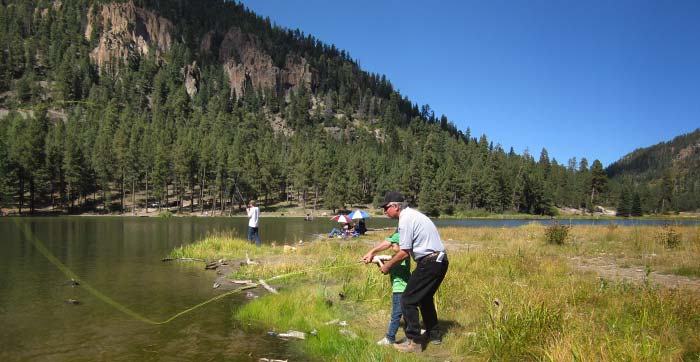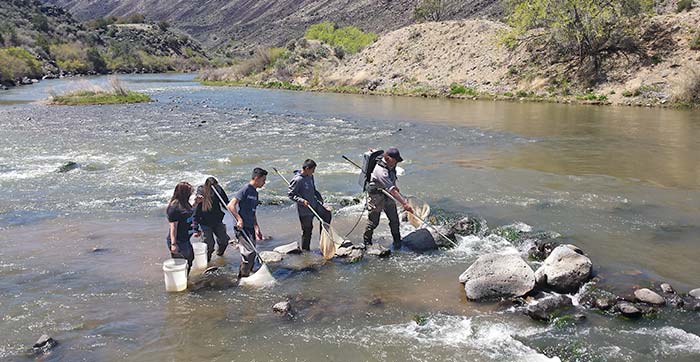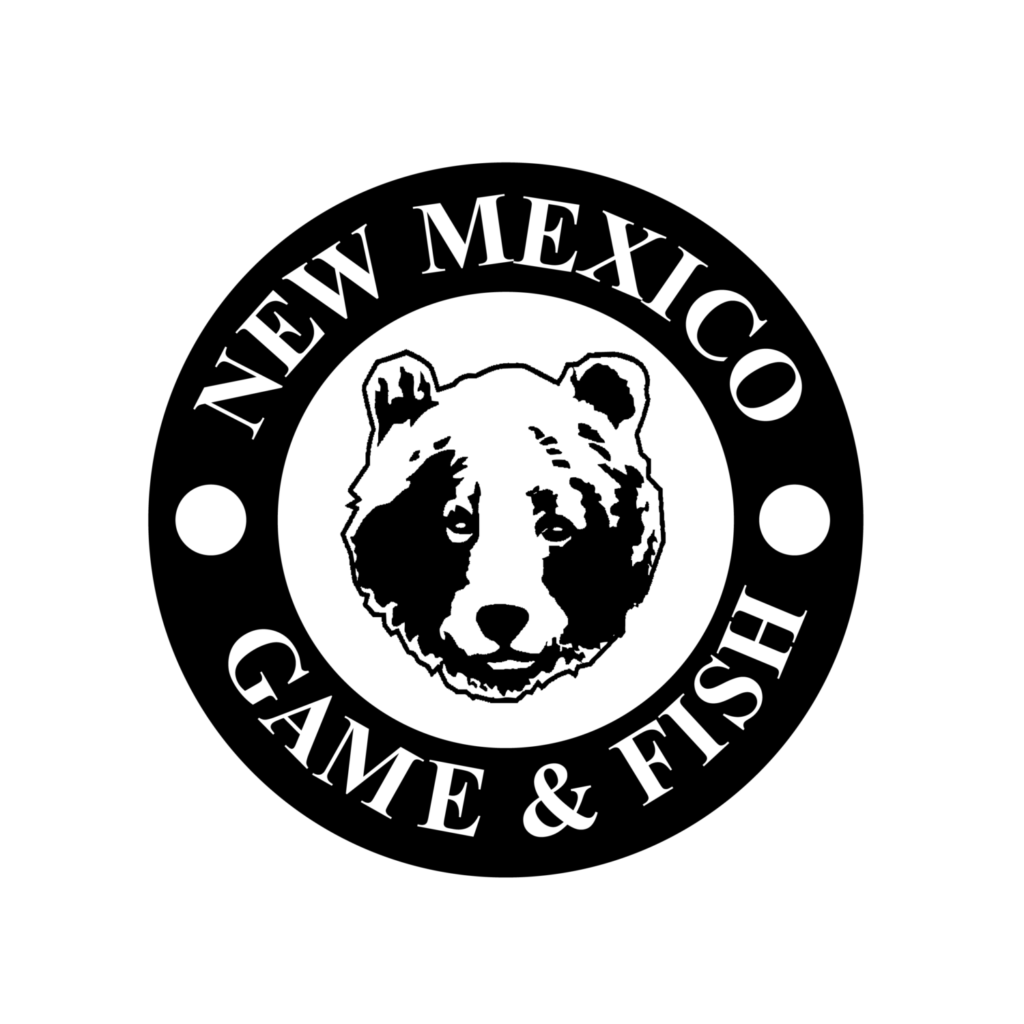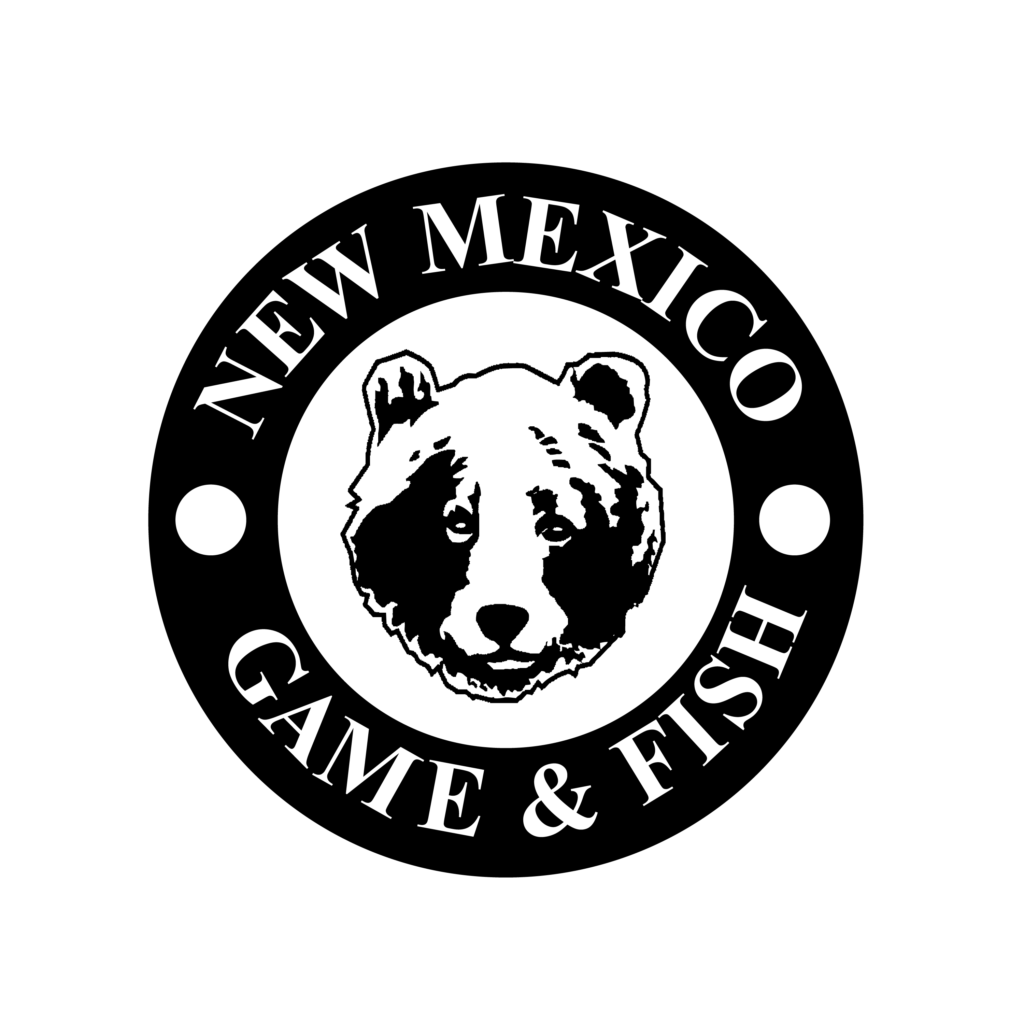
Gone Fishing
Students learn about local fish species, fish habitat and the scientific method by engaging in a fishing expedition.
Overview

Dan Williams, NMDGF provides fly-fishing instruction during Fishing Skills Youth Camp at Fenton Lake State Park.
Grade level: 6-12
Content Areas: Science, Physical Education, Angling Education
Objectives: Students will
(1) develop and write questions and detailed procedures for investigating fish species and habitat though angling,
(2) collect, organize and analyze data to draw conclusions,
(3) explain necessary preparations and safety considerations for a fishing trip, and
(4) demonstrate proficiency in assembling and casting a fishing rig
Method: After making simple fishing rigs and practicing casting, students will conduct a field investigation focused on fish and fish habitat.
Materials:
To plan investigation— view Fishing Trip tab.
For fishing—need rods and reels, or cane type fishing poles, or hand line or casting rigs that students make.Additional fishing equipment needed:
hooks
bobbers
appropriate lures
flies or bait
long-nose pliers to help remove hooks from fish
bucket or tub
linen/cotton/nylon gloves
fish field guide
ruler
first-aid kit
adhesive tape
fish stringer and/or ice and cooler to keep fish you are planning to eat or dissect
a balance or spring scale for weighing fish
sport fishing regulations for the area (see Publications page)
Lesson and Activity Time: Two or three 45 minute sessions plus a field investigation day. Support from other adults with fishing experience is recommended.
Location: Indoors/outdoors, field investigation in fishable waters
Common Core State Standards:
Mathematics
Grade 4-Numbers and Operations-Fractions-NF.1,2,3d.Measurement and Data-MD.4.
Grade 6:- Ratios Proportions-RP.1,2,3.
New Mexico Science Standards and Benchmarks:
Strand II, Standard II (Life Science) 5-7 Benchmark I.
Educator Information
Vocabulary: controlled variable, manipulated variable, responding variable, angling, spin casting, catch-and-release, fishing ethics, regulations, clinch knot, habitat, adaptations, sport fishing,
Study Site: Identify the specific fishing site at which the group will fish and conduct the investigation. Consult with angler education staff with New Mexico Game and Fish, local angling groups or public lands agencies for suggested sites close to your school or facility e.g. rivers, shorelines or urban fishing ponds. For comparative or correlative investigations, consider the option of fishing and data collection at multiple locations within one body of water as well as from different bodies of water.
Background: Fishing is an ancient practice with archeological evidence dating back 40,000 years. Hunter-gathers fished for food. Recreational fishing for sport or leisure dates back to the 16th century. People fish not just for food but to experience natural beauty and solitude. Some enjoy the challenge of catching fish, or perhaps just being out on the water. Many people benefit from the camaraderie of others with related hobbies such as fly-tying, rod making, entomology, taxidermy and photography. Fishing with a rod, reel, fishing line and bait, also known as “angling,” is a popular outdoor activity for many people that adds fun to camping, canoeing, boating and travel. Fishing also provides opportunities to investigate local fish populations and habitats at sites in urban and rural settings.
Fisheries management ensures the wise use of fish resources so that future generations also have fish and healthy fish habitat. Regulations are an essential part of fisheries management and serve to restrict the locations, seasons and equipment for catching fish as well as the species, quantities and size of fish caught. The sale of fishing licenses is the main funding source for state wildlife agencies to manage fish populations. Age requirements for licenses, fishing regulations and other information about fishing is published annually by New Mexico Department of Game and Fish.
More than 250,000 anglers visit our state’s lakes and streams every year.
Procedure
Introducing the Field Investigation:
- Discuss with students their knowledge and experiences with fishing. Why do people go fishing? Has anyone in the group been fishing before or know anyone that fishes? What do they know about fish and fishing?
- Explain that one of the benefits of fishing is an opportunity to learn more about local fish species and habitats. What would students like to learn about fish and where they live?
Record questions on a board or a tablet. Students’ “big picture” questions might include:– What is needed to provide fish habitat or a good fishing spot?
– What makes a healthy aquatic environment for fish and other species?
– How can our community sustain healthy aquatic environments?
- Discuss plans to visit a local site to conduct a fishing investigation.
Form the Question:
- From the list of questions previously generated, are there any the class can try to find answers to by fishing at the site? If not, help articulate researchable questions. Students can record their big picture questions and their more focused researchable questions. Examples include: What fish species are at the study site? How many fish might we catch in this particular water?
- Discuss students’ questions. Can they be answered through information gathered by fishing? Are there other data collection methods, in addition to catching fish that might also help answer questions? Help students decide what questions will be investigated. Choosing a single investigative question for whole class to investigate will allow educators to more easily assist students as they collect data. The increased amount of data relating to a single question should also help improve reliability and accuracy when drawing conclusions.
See “Questions to Investigate” in Appendix tab for possible research questions.
Conducting the Field Investigation
- Review the Fishing Trip tab section with students and make necessary preparations. Assemble your supplies and gear, review safety measures, discuss expectations, what to wear, fishing ethics e.g. who needs a license.
- Practice casting, knot-tying, bait placement as needed.
- After revisiting your investigative question, identify the variables in your research. For comparative and correlative questions, help students identify which conditions will be changed (dependent variable) and which conditions will be measured (independent variable).
- Discuss and plan with students what type of data should be collected and how data will be collected. What type of information and observations will be needed to answer the research question? How will you go about collecting data? Why is it important for all students to take measurements the same way? Similarly, why is it important to take measurements the same way when collecting data at different times or locations?
- Explain what a controlled variable is i.e. we determine a way to control how we take measurements, collect samples or make observations in order to ensure we are doing it the same way each time. As an example, if we are investigating at which location in a pond we are more likely to catch fish, we might use the same type of bait at each location for one of our controlled variables. This way, we know that if greater numbers of fish are caught in one location rather than another, the difference is not explained by the type of bait used.
- Have students write a plan for conducting the investigation, including: a) a prediction or hypothesis about what they will find or how their question will be answered, b) materials they will need to conduct the investigation, c) the independent variable, the dependent variable and at least one controlled variable d) each step they will take, with enough detail so others could read the steps to conduct the same experiment.
- Plan to enter data directly into student science notebooks or create a data collection form. See “Criteria for Student Data Forms” in the Appendix.
- Note: data collection involving identification of species (such as fish) or nonliving components found at the study site may be difficult without prior experience. In such cases, encourage students to make and label illustrations and take photographs or video that they can later refer to when using field guides back in the classroom. See these links to Cold Water Species and Warm Water Species.
- Go fishing! After arrival at the study site, students can record and describe the site conditions and description. In pairs or small groups, students record observations about the fish caught or other relevant variables at the site.
- If it is possible, go fishing again and repeat the investigation for improved accuracy.
Organizing and Analyzing the Data
- Back in the classroom, record and display a summary of the cumulative results.
- What calculations will help answer the research question? How can the data be best displayed graphically? Are any patterns found in the data?
- For comparative and correlative investigations, describe how sampling, measurements and observations were kept consistent for the two or more locations, times, or organisms (your controlled variables) and how they were random and representative of the site.
Drawing Conclusions
- Students write a clear statement explaining the answer to the research question that is limited to the study site, date and time, and that provides both the lowest and highest ranges in the data.
- Ask students to describe any problems they may have experienced when collecting data? Were there any factors that might have impacted the research (time of day, weather, angler competition, fish habitat conditions or stocking schedule etc.).
- Were the procedures students developed logical and sufficiently detailed to provide data needed to answer the research question? If not, how could the procedures be modified?
- What other data would help answer the research question?
Extension
Research the method fisheries managers use known as creel surveys or angler surveys to gather data on fish populations. Conduct a creel survey at a local popular fishing site. A creel survey involves interviewing anglers, measuring fish caught, keeping track of hours fished, counting boats, recreational craft, etc. When the data is analyzed we can get information about the amount of angler effort, fish harvest, and size distribution of different species of fish that were caught. We can also get an idea of fishing quality and the amount of ‘pressure’ or visitation the fishing area has experienced from anglers. A creel survey is a valuable tool in the fisheries managers tool box. See [wpfilebase tag=file id=1475 tpl=filebrowser /].
- Invite an experienced angler(s) to visit the class and /or accompany the students on a fishing trip. Anglers can provide assistance and tips, relate personal experiences and demonstrate fishing tackle.
- Have students make a journal to record their fishing experiences, with a chart to record date, time or fishing, weather, name and location of the body of water, type of gear and bait used, fish caught and size, whether fish were released or kept, how fish were cooked and how they tasted. They should leave space to record interesting observations and a description of the experience. Discuss how such information would be useful to the fisheries manager. This can also be done through various websites where everyone can view each other’s work and post comments etc.
a) Have students report length, weight of fish caught, and calculate mean, median, and mode for each species.- Have students research if the body of water they were fishing in was stocked recently. How might have affected their fishing experience? See the Weekly Fishing & Stocking Report page.
- Catch and study live bait (aquatic invertebrates, worms, grasshoppers, crickets, minnows).
- Examine commercially or skillfully made lures or flies. Students then make their own with barbless hooks, clothespins, modeling clay, aluminum foil, paint, markers, waterproof glue, colored chenille stems, colored yarn, fabric, fur, feathers, etc.
- Observe the action of commercial or homemade lures in a tank of water, and investigate what characteristics make some wiggle, spin or dive.
- Design a travel brochure with tips and tricks for organizing a good fishing trip.
Evaluation
- Have students list other questions they generated during the field investigation that they did not explore. Which of these questions are researchable? How would they find the answers to these questions?
- Ask students to explain why or why not they think angling is an accurate or meaningful way to gather information on the overall health of the water and habitat at their study site.
- What can students do to help maintain or improve habitat for a diversity of fish species at the fishable waters/study site?
Conservation/Natural Resources Work
What are some other tools and techniques used by aquatic biologists to gauge fish populations and assess fish habitat? Search for information on aquatic macroinvertebrate surveys, electro-shocking fish surveys or creel surveys.

Richard Hansen, Coldwater Supervisor, NMDGF Fisheries Management Division gets assistance from Taos and Questa High School students in conducting fish surveys on the Rio Grande. Richard is using an electro-shock battery backpack to temporarily stun fish so they can be caught in a net held downstream or scooped up from the surface. They are conducting the April 2015 survey near the Taos Junction bridge.
Planning Your Fishing Trip
Getting Ready . . .
– Consult with New Mexico Department of Game and Fish to determine dates and locations at which students will be permitted to fish.
– Determine if fishing licenses will need to be purchased.
– Invite parents and other adult volunteers to come along and assist.
– Acquire life jackets (PFD’s) as needed.
– Encourage students to take swimming and water-safety lessons.
– Heed warnings for lightning and windstorms.
– Decide in advance if you will keep fish or release fish that you catch. Check regulations to see what kind of lures, bait are allowed and what fish species and sizes you are allowed to keep-if any.
– Practice your skills! See the sections on Knot-tying and Casting Rig and Casting Practice.
What to Bring . . .
– Dress for weather, and remember it is often windier and colder near water. Rain coats can double as windbreakers. Wear a sunhat and apply sunscreen lotion to exposed skin.
– Protect your eyes—sunglasses and baseball caps or other hats with brims can protect the eyes from fish hooks when casting and reeling in.
– In addition to protection from the sun, hats and sunglasses provide additional protection from fish hooks when casting or reeling in line.
– Bring a first-aid kit and insect repellent.
– Use barbless hooks, or flatten the barb with pliers.
– Fishing gear (see “Basic Fishing Tackle” below).
– Don’t forget a fish stringer and a cooler with ice if you are planning to bring home fish to eat or dissect.
While Fishing . . .
– Always be careful near water. Beware of steep or slippery banks, strong currents or docks without protective railings.
– As necessary, fit life jacket (PFD) on students.
– Handle fish carefully, with wet hands. Take care with sharp teeth, spines and gill covers.
– When ice fishing, be sure you are on sound blue ice that is at least 10 inches thick. Check with state agencies that announce when ice is thick enough for ice fishing.
Fishing Ethics . . .
– Obey fishing and boating laws.
– Support conservation efforts.
– If not keeping fish, practice catch and release.
– Practice safe angling and boating.
– Respect other anglers’ rights.
– Share fishing knowledge and skills.
– Protect fish by never releasing live bait into waters.
– Properly recycle and dispose of trash.
Basic Fishing Tackle
Tackle includes poles, reels and many fishing accessories such as sinkers, hooks, lures and bobbers. Spincasting tackle is easy for beginning anglers and is the most popular type of fishing equipment in use today. The spincasting reel mounts to the top of the pistol-type handle or grip on the rod. Most rods are 4 ½ to 6 feet in length. Spincasting reels work using a push button to release the line to be able to cast out into the water. Set the drag so that line is released when a firm tug is given. There is a drag adjustment in front of the thumb button. They also have an anti-reverse lever that prevents turning the handle backward and forces the drag system to slow the line leaving the reel as a fish pulls. Spincasting tackle is best used for smaller fish in fresh water. It is ideal for bluegill, bream, small catfish, bass, and trout
Fishing line is made of nylon, called monofilament. It is used for most casting. Fishing line comes in a variety of sizes or strengths, called pound-test. The pound test refers to the amount of force it takes to break the line. The larger the line size, the stronger it is. Six pound test line is more flexible and casts easily. It is advisable to match your fishing line to your rod and reel capacity and to the species of fish you want to catch. Six pound test line is best suited for most fishing.
Bait can include natural baits such as worms, insects and minnows. Check the fishing regulations to make sure the bait you select is legal for the water you fish. Live minnows and other live fish are illegal to use in many states. If live bait is used, left over bait fish should never be released into the water.
Prepared baits can be made from bread and cheese. Commercially made baits are available in abundance. A few examples include salmon eggs for trout and floating paste-type bait available in many colors. Canned corn and hot dogs can also be used for bait
Artificial lures can include jigs, spoons, plugs and spinners. These are available in a wide variety of sizes, shapes and colors.
As students learn about fish behavior, they will also learn more about how to choose the best bait for different situations. Discovering which bait works best for the particular fish and the body of water can be an important experience of investigation.
Knot-tying
Before your trip, practice tying a fishing line on a barbless hook with a clinch knot. Links to online demonstration videos are available online. If helping younger children learn to tie knots, show them how to first practice with a fairly large diameter string and paper clip. Be sure to demonstrate safe handling of hooks.
Build a Casting Rig
If a rod and reel is not available or desired, an alternative is to make a tin can casting rig. Make sure the tin has no sharp edges by covering it with tape. Tape one end of a 30 foot piece of fishing line to the can near the closed end. Carefully wrap the line around the can toward the open end, trying not to overlap it. Too many overlaps may spoil the cast. When all the line is wound, tie a casting weight to the end, and secure the end with the rubber band.
For each participant, you will need: tin can, elastic or rubber band, 3 feet of rope; thick string (30 cm long); paper clips; scissors; 30 feet (or more) fishing line of about six lb. test strength); 1 small (size 6-8) barbless hook, or use pliers to bend down the barb; adhesive tape; a sinker (e.g., 4 to 6oz split-shot, non-lead sinker).
If you do not wish to use baited hooks, you could use artificial lures such as spinners or artificial flies on a clear, floating bobber.
Casting Practice
Practice casting and reeling in, To designate a casting area, use chalk on pavement or align ropes on grass to represent a stream or lake shoreline, including the features that might harbor a fish and obstacles to avoid (rocks, logs, fast water, pools, vegetation, etc.). Casting targets could be as simple as cardboard boxes or hula-hoops on a gym floor. Upside-down aluminum pie plates make good targets because they reward good aim with a loud bang.
A Few Fishing Tips
There are many fishing techniques. The easiest fishing method for most areas is to just cast a line out and simply wait with the hook dangling from a bobber or resting on the bottom. If the hook is not too deep in the water, you can see light-colored bait. Watch for the bait disappearing from sight. This signals that the fish has taken the bait, and that it’s time to set the hook by jerking the line.
If fishing with a spinner, move it regularly by jigging it, or by casting it out and reeling it in. The advantage of casting is that it can place the bait or lure where the student cannot reach, and it adds the attraction of movement for the fish. Cast bait gently into the water, not too close to the fish. Retrieve the line slowly. Have students drop the bait gently into the water and keep it off the bottom. They should watch, and feel for fish nibbling their lure or swallowing it.
When a fish takes the bait, students should set the hook, pull it toward the surface and scoop it up in a net. If this is not possible, they should lift the fish out of the water and lower it into a bucket of water. Keep any fish you plan to eat on a stringer in the water, or clean them and place in a cooler.
Catch-and-Release
Unless you plan to eat the fish you catch, you will want to release them. Many anglers fish to just be outdoors and enjoy the experience. Many anglers release fish so they can be caught again. By carefully releasing fish, students will demonstrate good angling ethics. Fish that are too small to keep will also need to be released. Carefully check the area’s sport fishing regulations.
The most critical aspect of releasing fish is to do so quickly. A fish may die of exhaustion if played on the line for too long. If possible, keep the fish in water so it can breathe. Hold it firmly but gently. Sliding the hook out will be easier if you use barbless hooks. Long-nosed pliers will be useful if the hook is deep in the fish’s mouth. If the hook is barbed, and cannot be removed without tearing flesh, cut the line and leave it in.
If the fish is still struggling, release it gently into the water. Do not put it directly into a fast current because it may need time to regain strength.
If the fish is unconscious, you may be able to revive it. Hold the fish upright in water heading upstream. Move it gently forward in a figure-eight pattern, so that fresh water flows through the gills. Release the fish as soon as it begins to struggle. Be careful- if too much motion then water will not pass over the gills properly. You will ‘drown’ the fish!
For more information visit Department Game and Fish website and the Recreational Boating and Fishing Foundation www.takemefishing.org website for more detailed information on everything related to angling and fishing skills.
Appendix
Sample Creel Survey Forms:
[wpfilebase tag=file id=1475 tpl=simple /]Questions to Investigate
Questions that help describe could include…
– What fish species are at the study site?
– How many fish might we catch in this particular water?
– What species of fish are possible to catch?
– What are the physical characteristics of the fish species caught?
– What is the ratio of fish species we will catch (e.g. 2 catfish: 1 carp)?
– What is the range of sizes of fish we might catch?
Questions that help compare could include…
– How do these physical characteristics—such as shape, color, weight, length—compare between species?
– Will one area of the fishing water have greater angler success than another?
– Will one type of bait/lure show greater catching success than another?
Questions that help correlate could include . . .
– Is there a relationship between the type of lure or bait used and the number of fish or species of fish caught?
– Is there a relationship between the hook size or fishing tackle used and the number of fish caught?
– Is there a relationship between the experience (number of times they have gone fishing) of the angler and the number of fish caught?
– What about angling pressure? Would we expect to see a relationship between the number of anglers in one particular area and the number of fish caught?
-What about the time of day? Would we expect to catch more fish earlier in the day or later on?
Discussion
-Was this fishing activity useful in learning how to conduct field investigations? Why or why not?
Criteria for Student Data Sheets
Data collection form should include:
A. Name(s) of individuals collecting the data.
B. The research question and a prediction of the answer to the question. Note that for comparative and correlative investigations, good questions describe what variable is changed (the manipulated variable).
C. Study site conditions—including date, time, location (GPS Coordinates if available), and weather conditions.
D. A description of the study site, in writing and, if the question involves spatial variables, a map as well (see Guidelines for Mapping).
E. A data table that includes the following conventions:
1. A clear title describing what is changed (manipulated variable) and what is observed/ measured (responding variable).
2. A clearly labeled column on the left hand side of the table to record observations of the manipulated variable.
3. Responding variable labeled across top row.
4. Spaces to record multiple observations or trials.
5. Observations/ counts/ measurements made with proper units.
Adapted from Field Investigations: Using Outdoor Environments to Foster Student Learning of Scientific Processes, 2007. Pacific Education Institute & Association of Fish & Wildlife Agencies.

